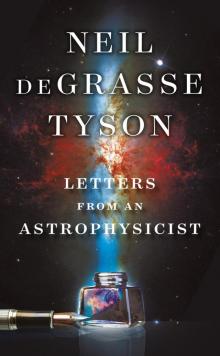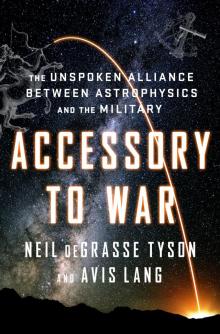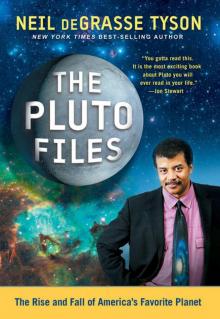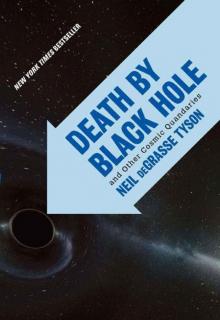- Home
- Neil DeGrasse Tyson
Death By Black Hole & Other Cosmic Quandaries
Death By Black Hole & Other Cosmic Quandaries Read online
Praise for
DEATH BY BLACK HOLE
“Tyson proves that no topic is too big or small for his scrutiny…. [He] tackles an impressive range of subjects…with great humor, humility, and—most important—humanity.”
—Wook Kim, Entertainment Weekly
“[Tyson] demonstrates a good feel for explaining science in an intelligible way to interested lay readers; his rather rakish sense of humor should aid in making the book enjoyable.”
—Library Journal
“Neil deGrasse Tyson has mined his columns from Natural History magazine for his most interesting essays on exploring the cosmos [written] in his characteristically fun and jaunty style.”
—Sky and Telescope
“Highly enjoyable.”
—Bookends
“…Tyson’s style will connect with general readers. Whatever readers’ scientific tastes, something in Tyson’s wide-ranging collection will sate them.”
—Gilbert Taylor, Booklist
“Vibrant collection of essays.”
—Book Passage
“Dr. Tyson has a grand time dissecting certain forms of foolishness. Get it, plan to savor it. Savor ‘Coming to Our Senses,’ a gorgeous dissection. It’s one of those essays that makes you call up your friends and start reading quotes over the phone. Light, elegant and rich.”
—Angela Gunn, USAToday.com
“An exciting journey through the extremes of the universe.”
—Commonwealth Science News
“The ideal book for those fascinated by space, the cosmos, black holes, and all the questions and wonders therein. The perfect book for the reader who wants simple and clearly defined answers.”
—Alex Telander, Bookloons.com
“Tyson comes across as having an excellent grasp of the current state of astrophysics, cosmology, chemistry and other scientific disciplines…he conveys knowledge clearly to the nonspecialist, often with ingratiating humor and wit.”
—Roy E. Perry, The Tennessean
“[An] eclectic mix of subjects…. Of most value in the book is Tyson’s thorough explanation of each subject, enlarging the reader’s understanding, even about familiar things.”
—Kathy Avakian, Journal of Amateur Astronomers Association of New York
DEATH BY BLACK HOLE
ALSO BY NEIL DEGRASSE TYSON
Origins: Fourteen Billion Years of Cosmic Evolution
(with Donald Goldsmith)
My Favorite Universe
(A 12-Part Video Lecture Series)
One Universe: At Home in the Cosmos
(with Charles Liu & Robert Irion)
Cosmic Horizons: Astronomy at the Cutting Edge
(with Steven Soter, eds)
The Sky Is Not the Limit:
Adventures of an Urban Astrophysicist
Just Visiting This Planet
Universe Down to Earth
Merlin’s Tour of the Universe
NEIL DEGRASSE TYSON
DEATH BY BLACK HOLE
AND OTHER COSMIC QUANDARIES
W. W. NORTON & COMPANY
New York • London
Copyright © 2007 by Neil deGrasse Tyson
All rights reserved
For information about permission to reproduce selections from this book, write to Permissions, W. W. Norton & Company, Inc., 500 Fifth Avenue, New York, NY 10110
Production manager: Amanda Morrison
Library of Congress Cataloging-in-Publication Data
Tyson, Neil deGrasse.
Death by black hole: and other cosmic quandaries / Neil deGrasse Tyson.—1st ed.
p. cm.
Includes bibliographical references.
ISBN: 978-0-393-11378-5
1. Black holes (Astronomy) 2. Cosmology. 3. Astrobiology. 4. Solar system. 5. Religion and science. I. Title.
QB843.B55T97 2007
523.8'875—dc22
2006022058
W. W. Norton & Company, Inc., 500 Fifth Avenue, New York, N.Y. 10110
www.wwnorton.com
W. W. Norton & Company Ltd., Castle House, 75/76 Wells Street, London W1T 3QT
CONTENTS
Preface
Acknowledgments
Prologue: The Beginning of Science
SECTION 1 THE NATURE OF KNOWLEDGE
The challenges of knowing what is knowable in the universe
1. Coming to Our Senses
2. On Earth as in the Heavens
3. Seeing Isn’t Believing
4. The Information Trap
5. Stick-in-the-Mud Science
SECTION 2 THE KNOWLEDGE OF NATURE
The challenges of discovering the contents of the cosmos
6. Journey from the Center of the Sun
7. Planet Parade
8. Vagabonds of the Solar System
9. The Five Points of Lagrange
10. Antimatter Matters
SECTION 3 WAYS AND MEANS OF NATURE
How Nature presents herself to the inquiring mind
11. The Importance of Being Constant
12. Speed Limits
13. Going Ballistic
14. On Being Dense
15. Over the Rainbow
16. Cosmic Windows
17. Colors of the Cosmos
18. Cosmic Plasma
19. Fire and Ice
SECTION 4 THE MEANING OF LIFE
The challenges and triumphs of knowing how we got here
20. Dust to Dust
21. Forged in the Stars
22. Send in the Clouds
23. Goldilocks and the Three Planets
24. Water, Water
25. Living Space
26. Life in the Universe
27. Our Radio Bubble
SECTION 5 WHEN THE UNIVERSE TURNS BAD
All the ways the cosmos wants to kill us
28. Chaos in the Solar System
29. Coming Attractions
30. Ends of the World
31. Galactic Engines
32. Knock ’Em Dead
33. Death by Black Hole
SECTION 6 SCIENCE AND CULTURE
The ruffled interface between cosmic discovery and the public’s reaction to it
34. Things People Say
35. Fear of Numbers
36. On Being Baffled
37. Footprints in the Sands of Science
38. Let There Be Dark
39. Hollywood Nights
SECTION 7 SCIENCE AND GOD
When ways of knowing collide
40. In the Beginning
41. Holy Wars
42. The Perimeter of Ignorance
References
My own suspicion is that the Universe is not only queerer than we suppose, but queerer than we can suppose.
—J. B. S. HALDANE
Possible Worlds (1927)
PREFACE
I see the universe not as a collection of objects, theories, and phenomena, but as a vast stage of actors driven by intricate twists of story line and plot. So when writing about the cosmos, it feels natural to bring readers into the theater, behind the scenes, to see up close for themselves what the set designs look like, how the scripts were written, and where the stories will go next. My goal at all times is to communicate insight into how the universe works, which is harder than the simple conveyance of facts. Times arise along the way, as for the drama icon itself, to smile or to frown when the cosmos calls for it. Times arise to be scared witless when the cosmos calls for that, too. So I think of Death by Black Hole as a reader’s portal to all that moves, enlightens, and terrifies us in the universe.
Each chapter first ap
peared, in one form or another, on the pages of Natural History magazine under the heading “Universe” and span the 11-year period of 1995 through 2005. Death by Black Hole forms a kind of “Best of the Universe” and includes some of the most requested essays I have written, mildly edited for continuity and to reflect emergent trends in science.
I submit this collection to you, the reader, for what might be a welcome diversion from your day’s routine.
Neil deGrasse Tyson
New York City
October 2006
ACKNOWLEDGMENTS
My formal expertise in the universe concerns stars, stellar evolution, and galactic structure. And so I could not possibly write with authority about the breadth of subjects in this collection without the careful eyes of colleagues whose comments on my monthly manuscripts often made the difference between a simple idea described and an idea nuanced with meaning drawn from the frontier of cosmic discovery. For matters regarding the solar system, I am grateful to Rick Binzel, my former classmate in graduate school and now professor of Planetary Sciences at MIT. He has received many a phone call from me, in desperate search of a reality-check on what I had written or what I had planned to write about the planets and their environments.
Others in this role include Princeton Astrophysics Professors Bruce Draine, Michael Strauss, and David Spergel whose collective expertise in cosmo-chemistry, galaxies, and cosmology allowed me to reach deeper into that store of cosmic places than would otherwise be possible. Among my colleagues, the ones who are closest to these essays include Princeton’s Robert Lupton, who, being properly educated in England, looks to me as though he knows everything about everything. For most of the essays in this volume, Robert’s remarkable attention to scientific as well as literary detail provided reliable monthly enhancement to whatever I had penned. Another colleague and generalist who keeps watch over my work is Steven Soter. My writings are somehow incomplete without first passing them to his attention.
From the literary world, Ellen Goldensohn, who was my first editor at Natural History magazine, invited me to write a column in 1995 after hearing me interviewed on National Public Radio. I agreed on the spot. And this monthly task remains one of the most exhausting and exhilarating things I do. Avis Lang, my current editor continues the effort begun by Ellen, ensuring that, without compromise, I say what I mean and mean what I say. I am indebted to both of them for the time they have invested to make me be a better writer. Others who have helped to improve or otherwise enhance the content of one or more essays include Phillip Branford, Bobby Fogel, Ed Jenkins, Ann Rae Jonas, Betsy Lerner, Mordecai Mark Mac-Low, Steve Napear, Michael Richmond, Bruce Stutz, Frank Summers, and Ryan Wyatt. Hayden volunteer Kyrie Bohin-Tinch made a heroic first pass at helping me to organize the universe of this book. And I offer further thanks to Peter Brown, editor-in-chief of Natural History magazine, for his overall support of my writing efforts and for granting permission to reproduce the essays of my choice for this collection.
This page would be incomplete without a brief expression of debt to Stephen Jay Gould, whose Natural History column “This View of Life” ran for three hundred essays. We overlapped at the magazine for seven years, from 1995 through 2001, and not a month passed where I did not feel his presence. Stephen practically invented the modern essay form, and his influence on my work is manifest. Wherever I am compelled to reach deep into the history of science, I would acquire and turn the fragile pages of rare books from centuries past, as Gould so often did, drawing from them a rich sampling of how those who came before us attempted to understand the operations of the natural world. His premature death at age 60, like that of Carl Sagan at age 62, left a vacuum in the world of science communication that remains to this day unfilled.
PROLOGUE:
The Beginning of Science
The success of known physical laws to explain the world around us has consistently bred some confident and cocky attitudes toward the state of human knowledge, especially when the holes in our knowledge of objects and phenomena are perceived to be small and insignificant. Nobel laureates and other esteemed scientists are not immune from this stance, and in some cases have embarrassed themselves.
A famous end-of-science prediction came in 1894, during the speech given by the soon-to-be Nobel laureate Albert A. Michelson on the dedication of the Ryerson Physics Lab, at the University of Chicago:
The more important fundamental laws and facts of physical science have all been discovered, and these are now so firmly established that the possibility of their ever being supplanted in consequence of new discoveries is exceedingly remote…. Future discoveries must be looked for in the sixth place of decimals. (Barrow 1988, p. 173)
One of the most brilliant astronomers of the time, Simon Newcomb, who was also cofounder of the American Astronomical Society, shared Michelson’s views in 1888 when he noted, “We are probably nearing the limit of all we can know about astronomy” (1888, p. 65). Even the great physicist Lord Kelvin, who, as we shall see in Section 3, had the absolute temperature scale named after him, fell victim to his own confidence in 1901 with the claim, “There is nothing new to be discovered in physics now. All that remains is more and more precise measurement” (1901, p.1). These comments were expressed at a time when the luminiferous ether was still the presumed medium in which light propagated through space, and when the slight difference between the observed and predicted path of Mercury around the Sun was real and unsolved. These quandaries were perceived at the time to be small, requiring perhaps only mild adjustments to the known physical laws to account for them.
Fortunately, Max Planck, one of the founders of quantum mechanics, had more foresight than his mentor. Here, in a 1924 lecture, he reflects on the advice given to him in 1874:
When I began my physical studies and sought advice from my venerable teacher Philipp von Jolly…he portrayed to me physics as a highly developed, almost fully matured science…. Possibly in one or another nook there would perhaps be a dust particle or a small bubble to be examined and classified, but the system as a whole stood there fairly secured, and theoretical physics approached visibly that degree of perfection which, for example, geometry has had already for centuries. (1996, p. 10)
Initially Planck had no reason to doubt his teacher’s views. But when our classical understanding of how matter radiates energy could not be reconciled with experiment, Planck became a reluctant revolutionary in 1900 by suggesting the existence of the quantum, an indivisible unit of energy that heralded an era of new physics. The next 30 years would see the discovery of the special and general theories of relativity, quantum mechanics, and the expanding universe.
With all this myopic precedence you would think that the brilliant and prolific physicist Richard Feynman would have known better. In his charming 1965 book The Character of Physical Law, he declares:
We are very lucky to be living in an age in which we are still making discoveries…. The age in which we live is the age in which we are discovering the fundamental laws of nature, and that day will never come again. It is very exciting, it is marvelous, but this excitement will have to go. (Feynman 1994, p. 166)
I claim no special knowledge of when the end of science will come, or where the end might be found, or whether an end exists at all. What I do know is that our species is dumber than we normally admit to ourselves. This limit of our mental faculties, and not necessarily of science itself, ensures to me that we have only just begun to figure out the universe.
Let’s assume, for the moment, that human beings are the smartest species on Earth. If, for the sake of discussion, we define “smart” as the capacity of a species to do abstract mathematics then one might further assume that human beings are the only smart species to have ever lived.
What are the chances that this first and only smart species in the history of life on Earth has enough smarts to completely figure out how the universe works? Chimpanzees are an evolutionary hair’s-width from us yet we can agree that no amount
of tutelage will ever leave a chimp fluent in trigonometry. Now imagine a species on Earth, or anywhere else, as smart compared with humans as humans are compared with chimpanzees. How much of the universe might they figure out?
Tic-tac-toe fans know that the game’s rules are sufficiently simple that it’s possible to win or tie every game—if you know which first-moves to make. But young children play the game as though the outcome were remote and unknowable. The rules of engagement are also clear and simple for the game of chess, but the challenge of predicting your opponent’s upcoming sequence of moves grows exponentially as the game proceeds. So adults—even smart and talented ones—are challenged by the game and play it as though the end were a mystery.
Let’s go to Isaac Newton, who leads my list of the smartest people who ever lived. (I am not alone here. A memorial inscription on a bust of him in Trinity College, England, proclaims Qui genus humanum ingenio superavit, which loosely translates from the Latin to “of all humans, there is no greater intellect.”) What did Newton observe about his state of knowledge?

 Letters from an Astrophysicist
Letters from an Astrophysicist Accessory to War
Accessory to War The Pluto Files: The Rise and Fall of America's Favorite Planet
The Pluto Files: The Rise and Fall of America's Favorite Planet Death By Black Hole & Other Cosmic Quandaries
Death By Black Hole & Other Cosmic Quandaries